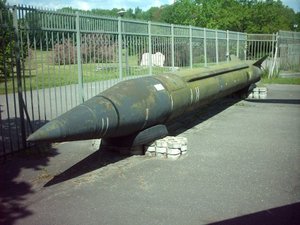Scud
|
|
- For the comic character, see Scud: The Disposable Assassin.

Scud is the popularized term for a series of tactical ballistic missiles developed by the Soviet Union during the Cold War and exported widely to other countries. The term comes from the NATO reporting name SS-1 Scud which was attached to the missile by Western intelligence agencies. The Russian names for the missile are the R-11 (the first version) and R-300 Elbrus (later developments). The name Scud has been used by media and other entities to refer to not only these missiles but to the wide variety of missiles developed in other countries based on the Soviet design. Occasionally in the United States, Scud is applied to any country's ballistic missiles not of western origin.
| Contents |
Soviet development
The first use of the term Scud was in the NATO name SS-1b Scud-A, applied to the R-11 ballistic missile. The earlier R-1 missile had carried the NATO name SS-1 Scunner, but was of a very different design, almost directly a copy of the German V-2. The R-11 used technology gained from the V-2 as well, but was a new design, smaller and differently shaped than the V-2 and R-1 weapons. The R-11 was developed by the Makeyev OKB and entered service in 1957.
Further developed variants were the R-300 Elbrus / SS-1c Scud-B in 1961 and the SS-1d Scud-C in 1965, both of which could carry either a conventional high-explosive, a 5 to 80 kiloton nuclear, or a chemical (thickened VX) warhead. The SS-1e Scud-D variant developed in the 1980s can deliver a conventional high-explosive warhead, a fuel-air warhead, 40 runway-penetrator sub-munitions, or 100 x 5 kg anti-personnel bomblets.
All models are 11.25 meters long (except Scud-A, which is one meter shorter) and 0.88 meters in diameter. They are propelled by a single engine burning either kerosene and nitric acid in the Scud-A, or UDMH and RFNA (Russian SG-02 Tonka 250) in other models.
Other development
The name "Scud" is also used to refer to an Iraqi modification of the same missile. Altered for greater range, it came to particular prominence during the Gulf War, when a number of missiles were fired at Israel (40) and Saudi Arabia (46). The US-made Patriot missile system claimed successes in shooting down the missiles, but many critics claim that the accuracy of the Patriot missiles has been greatly exaggerated and they were actually 85% unsuccesful. The missiles were one of Iraq's most threatening offensive weapons, especially to Israel. There was great concern that they would be armed with chemical or biological warheads.
In the end the Scuds were responsible for the death of one Israeli directly and for the deaths of 28 US soldiers (the missile struck a barracks in Saudi Arabia). The hunt for Scuds used up some one third of the Coalition air power. They were easily mobile carried on the backs of trucks and were hard to track down.
The Iraqis developed four versions: Scud, longer-range Scud, Al Hussein, and Al Abbas. Apart from the almost unmodified weapon these were not successful missiles as they tended to break up in flight and had small warheads.
The North Korean, Iranian, and Pakistani missile programs have used Scud technology to develop missiles with ranges said to be in the 1,300-to 1,500-kilometer range.
Operational use
All "Scud" versions derive from the German V-2 rocket (just like the majority of early American missiles and rockets) and are (very) inaccurate due to their construction. The Iraqi modifications increased range, at the cost of accuracy.
As with some other missiles, the military advantage of this weapon consists in its ease of transportation, on a TEL vehicle (transporter-erector-launcher). This mobility allows for a choice of firing position and increases the survivability of the weapon system (to such an extent, that of the approximately 100 launchers claimed destroyed by coalition pilots and special forces in the Gulf War not a single destruction could be confirmed afterwards).
Scud missile (including derivatives) is one of the few ballistic missiles to be used in actual warfare, second only to V2 in terms of combat launches (Tocka-U being the only other ballistic missile fired "in anger"). Besides the aforementioned Gulf War, Scud missiles were used in several regional conflicts, most prominently by Soviet forces in Afghanistan, and by the Iranians and the Iraqis in so called "War of the cities". The latter occurred in 1988, when in response to Iranian missile strikes against Baghdad, Iraq fired 190 Scud missiles at Iranian cities including Tehran. These strikes resulted in thousands of deaths and widespread panic in Iran, perhaps resulting in a more favourable peace treaty for Iraq. There was also a small number of Scud missiles used in the 1994 civil war in Yemen and by Russian forces in Chechnya in 1996 and onwards.
Countries that possess Scud-Bs are: Afghanistan, Armenia, Azerbaijan, Belarus, Bulgaria, Georgia, Kazakhstan, Libya, Poland, Slovakia, Turkmenistan, Ukraine, the United Arab Emirates, Vietnam, and Yemen. The Democratic Republic of Congo and Egypt have purchased Scud-Cs in addition to Scud-Bs. Syria has acquired the Scud-D, and Iraq's Al-Hussein missile also has a Scud-D range.
General characteristics
| NATO | Scud-A | Scud-B | Scud-C | Scud-D |
|---|---|---|---|---|
| U.S. DIA | SS-1b | SS-1c | SS-1d | SS-1e |
| Deployment Date | 1957 | 1965 | 1965 | 1980s |
| Withdrawn | 1978 | |||
| Range | 130 km | 300 km | 575-600 km | 700 km |
| CEP (NATO estimate) | 4000 m | 900 m | 900 m | 50 m |
See also
External links
- Global Security: R-11 / SS-1b SCUD (http://www.globalsecurity.org/wmd/world/russia/r-11.htm)
- The Scud Missile Syndrome (http://www.defencejournal.com/may99/scud-missile.htm)
- Kapustin Yar (http://kapyar.km.ru/) (Russian language)de:Scud
